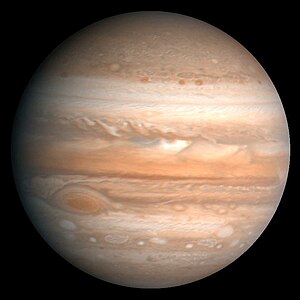木星
外观
 木星外觀 | |||||||||||||||
| 編號 | |||||||||||||||
|---|---|---|---|---|---|---|---|---|---|---|---|---|---|---|---|
| 發音 | Template:IPAc-en[1] | ||||||||||||||
| 軌道參數[5][lower-alpha 1] | |||||||||||||||
| 曆元 J2000 | |||||||||||||||
| 遠日點 | 5.458104 AU (816,520,800 km) | ||||||||||||||
| 近日點 | 4.950429 AU (740,573,600 km) | ||||||||||||||
| 半長軸 | 5.204267 AU (778,547,200 km) | ||||||||||||||
| 離心率 | 0.048775 | ||||||||||||||
| 軌道週期 | |||||||||||||||
| 會合週期 | 398.88 日[3] | ||||||||||||||
| 平均速度 | 13.07 公里/秒[3] | ||||||||||||||
| 平近點角 | 18.818° | ||||||||||||||
| 軌道傾角 | |||||||||||||||
| 升交點黃經 | 100.492° | ||||||||||||||
| 近日點參數 | 275.066° | ||||||||||||||
| 衛星 | 67 (Template:As of) | ||||||||||||||
| 物理特徵 | |||||||||||||||
| 平均半徑 | 69,911±6 km[6][lower-alpha 2] | ||||||||||||||
| 赤道半徑 |
| ||||||||||||||
| 極半徑 |
| ||||||||||||||
| 扁率 | 0.06487±0.00015 | ||||||||||||||
| 表面積 |
| ||||||||||||||
| 體積 |
| ||||||||||||||
| 品質 | |||||||||||||||
| 平均密度 | 1.326 g/cm3[3][lower-alpha 2] | ||||||||||||||
| 表面重力 |
24.79 m/s2[3][lower-alpha 2] 2.528 g | ||||||||||||||
| 逃逸速度 | 59.5 km/s[3][lower-alpha 2] | ||||||||||||||
| 恒星自轉週期 | 9.925 h[9] (9 h 55 m 30 s) | ||||||||||||||
| 赤道自轉速度 |
12.6 km/s 45,300 km/h | ||||||||||||||
| 轉軸傾角 | 3.13°[3] | ||||||||||||||
| 北極赤經 |
268.057° 17h 52m 14s[6] | ||||||||||||||
| 北極赤緯 | 64.496°[6] | ||||||||||||||
| 反照率 |
0.343 (Bond) 0.52 (geom.)[3] | ||||||||||||||
| |||||||||||||||
| 視星等 | −1.6到−2.94[3] | ||||||||||||||
| 角直徑 | 29.8″到50.1″[3] | ||||||||||||||
| 大氣[3] | |||||||||||||||
| 表面氣壓 | 20–200 kPa[10] (cloud layer) | ||||||||||||||
| 大氣標高 | 27 km | ||||||||||||||
| 成分 |
by volume:
冰: | ||||||||||||||
|
| |||||||||||||||

木星,亦叫歲星,是太陽系八大行星裏向頂大個行星,離太陽第五遠。木星屬於氣體大行星,搭土星、天王星、海王星一樣;俚還是太陽系頂多衛星個行星(63隻),搭仔自轉頂快個行星(9.925個鐘頭)。老底子中國人叫俚「歲星」,是因為俚公轉查弗多12年,等於地支一個循環。西方人叫俚Jupiter,源自羅馬神話裏向個眾神之王,相當於希臘神話個宙斯。
木星有光環,不過就弗容易看見。木星表面有大大小小個風暴,其中頂出名個風暴是「大紅斑」。
歲星出沒,查弗多一歲,古時人日出望東,用俚來定一年開始。
註解
[编辑]還好看看
[编辑]参考资料
[编辑]- ↑ Jupiter, entry in the Oxford English Dictionary, prepared by J. A. Simpson and E. S. C. Weiner, vol. 8, second edition, Oxford: Clarendon Press, 1989. ISBN 0-19-861220-6 (vol. 8), ISBN 0-19-861186-2 (set.)
- ↑ Seligman, Courtney. Rotation Period and Day Length. 访问日脚2009年8月13號.
- ↑ 3.00 3.01 3.02 3.03 3.04 3.05 3.06 3.07 3.08 3.09 3.10 3.11 3.12 3.13 Williams, David R. (2004年11月16號). Jupiter Fact Sheet. NASA. 访问日脚2007年8月8號.
- ↑ The MeanPlane (Invariable plane) of the Solar System passing through the barycenter (April 3, 2009). 访问日脚2009年4月10號. (produced with Solex 10 档案,存勒互联网档案馆当中。(2015年5月24号) written by Aldo Vitagliano; see also Invariable plane)
- ↑ Yeomans, Donald K. (2006年7月13號). HORIZONS Web-Interface for Jupiter Barycenter (Major Body=5). JPL Horizons On-Line Ephemeris System. 访问日脚2007年8月8號. – Select "Ephemeris Type: Orbital Elements", "Time Span: January 1, 2000 12:00到2000-01-02". ("Target Body: Jupiter Barycenter" and "Center: Sun" should be defaulted to.)
- ↑ 6.0 6.1 6.2 6.3 6.4 Template:Cite doi
- ↑ Solar System Exploration: Jupiter: Facts & Figures. NASA (2008年5月7號).
- ↑ Astrodynamic Constants. JPL Solar System Dynamics (2009年2月27號). 访问日脚2009年8月8號.
- ↑ Seidelmann, P. K. (2001). Report of the IAU/IAG Working Group on Cartographic Coordinates and Rotational Elements of the Planets and Satellites: 2000. HNSKY Planetarium Program. 原始文档勒2018-09-30存档. 访问日脚2007年2月2號.
- ↑ Anonymous. Probe Nephelometer. Galileo Messenger (NASA/JPL). 1983年3月, (6) [2007年2月12號].
| |||||||||||||||||||||||||||||||||||||||||||||||||||||||||||||
